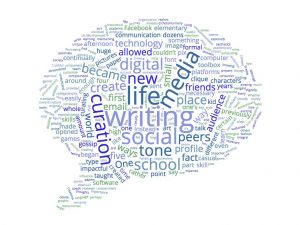
At the ripe old age of five, nothing could hold my attention longer than an afternoon on the old Macintosh desktop. The massive white box could have easily squished me if it fell, but the thrill of dozens of games on the computer was even greater than the physical threat. My tiny hands clutched the mouse, navigating simple, elementary games for hours, as my mother worked upstairs. When I discovered the kid pix software, a whole new world opened up for me; larger than the one the computer previously offered. The endless supply of digital paint, textures, and tools allowed my creativity to flourish in ways that crayons and construction paper could not support. This was the point of no return, so to speak, for my dependency on technology. The digital realm of basic children’s art allowed me to create dozens of masterpieces in an afternoon, and then easily delete them. Although it certainly did not teach me useful graphic design, the software was instrumental in developing my concept of art and initiative to create something that was uniquely mine.
Following kid pix, I began to explore the world of email in elementary school. Starting as a means to talk to my father when he was away on business trips, it quickly evolved into something much more impactful in my life. I invited my school friends to create their own Hotmail and Yahoo accounts, leading to the creation of a digital meeting place after school. We giggled at the cute puppy pictures we sent and the elementary-school gossip we exchanged. Automated signatures at the end of each email served as a quick snippet of one’s personality, while toying around with font, formatting, and text color conveyed a certain tone. Learning all of these casual communication intricacies changed the way I thought about conversing with my peers. Instead of engaging in pleasant bus stop small talk, I would be stuck in my own head curating my next fictional email to my friend Laura. Email opened up a new type of audience that had previously not existed for my generation. As I sent more emails, I learned more about what to say and what not to say; what was too formal, and what was too casual. These little conversations about homework and boys continually added digital writing skills to my toolbox, no matter how small the conversation. This huge volume of casual digital writing taught me important skills about curation. Little did I know, curation would be the key skill to learn for several years to come.
As I transitioned into my adolescent years, coupled with the increasing popularity of social media, digital images had a remarkably large impact on my life. Facebook became popular among my peers around 2009, despite the fact that none of us were thirteen yet—a requirement for creating a profile. Nonetheless, we all broke the law, and became members of a new social world. At first, I was a consumer rather than a producer. In fact, the only reason I made an account was to keep up with my friends and the fast-paced gossip flow that Facebook provided. It allowed me and my peers to further classify someone based on their profile, and to compartmentalize them into a clique. This made the skill of curation even more necessary to maintaining a sufficient social life. Creating a profile became a sort of social game, balancing the charm of your uniqueness while still fitting into the molds of a certain clique or compartment that you belonged to. The incessant curation became a daily ritual in my life which has sustained all the way to the present.
The feeling that social media first imparted on me has only multiplied as more and more platforms such as Instagram, Twitter, and Snapchat arose, requiring a great and greater amount of curation on my part. Each platform had its own culture and rules to learn, complete with their own language, tone, and aesthetics. At some points, curating my online persona was exhausting, while at other times, it was beyond captivating. Portraying my life in a clean-cut, streamlined fashion was exciting, particularly when others reacted positively towards my content. Whether it was pictures, tweets, or small tirades on society, I began to write and post to garner peer approval. In high school, that translated to distilling my thoughts down to trite clichés that fit to the viewpoints of those digitally “around” me. To me, it was bad writing, but to my peers, it was impactful, truthful writing. However, this casual style of writing did not negatively impact my formal, academic writing; rather, it improved those papers in terms of tone and organization. Social media taught me the importance of knowing your audience and the impact of tone. It created a dichotomy where I could place my writing and understand more fully the clarity and influence of those pieces, whether it was the 140 characters of a tweet or the 5,000 characters of a literary analysis paper.
As I journey my way through college, I find that social media plays an integral part in my life, both socially and academically. There are many platforms that I have had to join, in addition to the original media from high school. Every time it’s a new learning process to figure out the precise tone and style of writing to use, but my theoretical toolbox is continually being enriched with ways to navigate the evolutionary nature of technology.